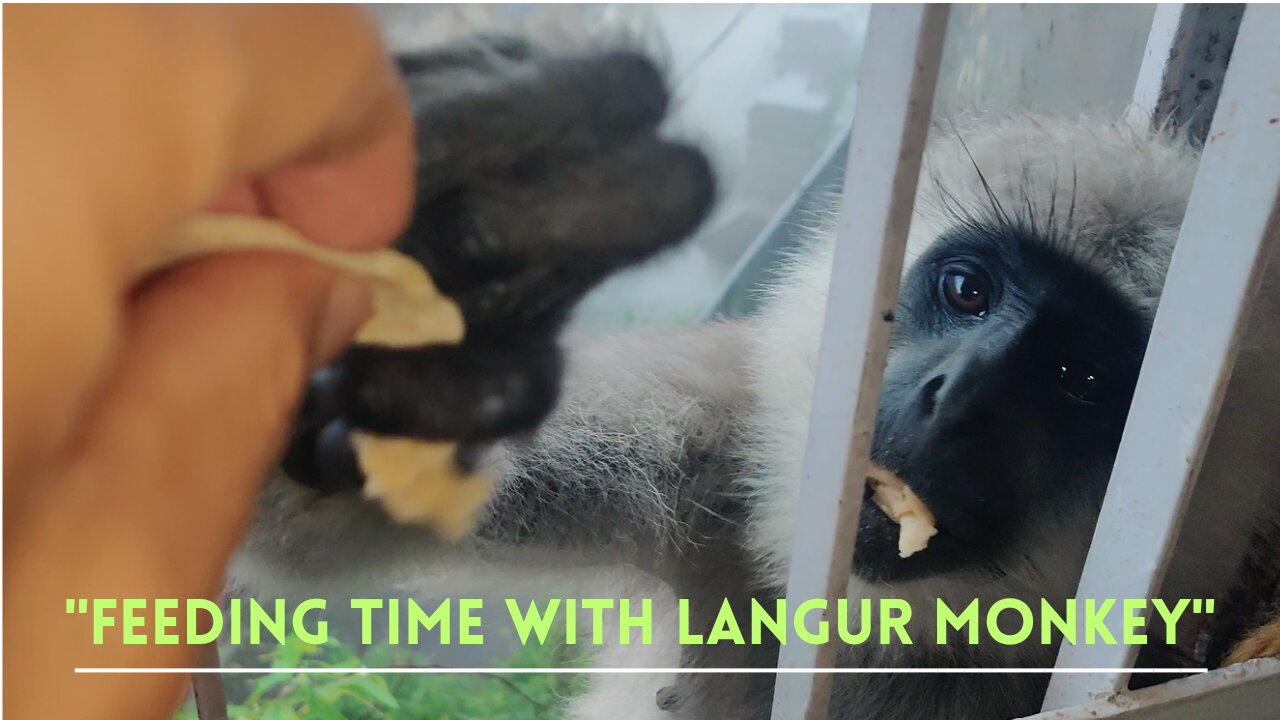Premium Only Content

"Feeding Time with Langur Monkeys: A Close Encounter with Nature's Graceful Herbivores"
"Feeding Time with Langur Monkeys: A Close Encounter with Nature's Graceful Herbivores"
Langurs, belonging to the Semnopithecus genus, are a fascinating group of Old World monkeys prevalent in various parts of Asia. These monkeys are recognized for their distinctive features, intricate social behaviors, and adaptability to a range of habitats.
Physical Characteristics:
Langurs typically possess elongated tails, often matching or even surpassing their body length. Their fur exhibits a spectrum of hues, spanning from gray to brown, with some species showcasing captivating color contrasts between their body and facial features. Unique tufts of hair on their heads can also distinguish certain species. The appearance of langurs varies, contingent on their species and the particular environment they inhabit.
Habitat and Distribution:
Renowned for their remarkable adaptability, langurs are found in an array of habitats encompassing tropical and subtropical forests, grasslands, and even urban areas. Their geographical distribution encompasses diverse countries across Asia, and each species occupies a distinct range. For instance, the Hanuman langur (Semnopithecus entellus) thrives in the Indian subcontinent, while the douc langur (Pygathrix spp.) resides in select regions of Southeast Asia.
Social Behavior:
Langurs display intricate social structures and behaviors. Often organized into multi-male and multi-female groups, these monkeys exhibit varying group sizes from small units to larger collectives. Hierarchies within these groups are established based on factors such as age, gender, and dominance. Distinct roles and interactions characterize male and female langurs, contributing to the unity of the group.
Diet:
These primates primarily follow a herbivorous diet, consuming leaves, fruits, flowers, and other plant matter. Their specialized digestive systems facilitate the extraction of nutrients from fibrous plant materials. However, their herbivorous diet necessitates prolonged feeding periods to fulfill their energy requirements.
Conservation Status:
The conservation status of langur species differs significantly. Some are classified as endangered or vulnerable due to threats like habitat loss and human hunting. The destruction and fragmentation of their habitats, often driven by factors such as deforestation and urban expansion, have led to population declines. Additionally, langurs are sometimes targeted for their body parts, sought after for traditional medicine or the exotic pet trade.
Cultural Significance:
Langurs hold cultural and spiritual significance in certain societies and religions. Notably, the Hanuman langur, named after the deity Hanuman in Hinduism, is revered and protected in various parts of India due to its association with religious beliefs.
In light of their captivating behaviors and adaptability, langurs play a crucial ecological role in their respective habitats. Conservation initiatives that prioritize habitat protection and raise awareness about their importance are indispensable for ensuring the survival of langurs amidst ongoing environmental challenges.
#monkey #animals #animallover #monkeys #langurmonkey #feedingmonkey #feedinglangur #cuteanimals #cutemonkey #shimlamonkey #careanimals #monkeycartoon @NatGeo @emmrob1 @DiscoveryKidsLAT @Discover @TheGlobalAnimalsWorld @YouTube @blessedbaritone
#kidsvideo #cartoons #cartoonvideo
-
 LIVE
LIVE
Joe Donuts Live
1 hour ago🟢 Loot Rats Unleashed: Arena Breakout Chaos! | Joe + Tony + Vlad
1,582 watching -
 11:18
11:18
Dr Disrespect
2 days agoDr Disrespect: THE BEST AND WORST OF GAMESCOM 2025
128K22 -
 LIVE
LIVE
Boxin
46 minutes agoGrounded! part 5
166 watching -
 2:10:12
2:10:12
Badlands Media
1 day agoDevolution Power Hour Ep. 383: Epstein, Durham, and the Dictator Narrative
95.6K74 -
 2:40:10
2:40:10
DLDAfterDark
11 hours ago $0.49 earnedDLD Live! Feat. Red Dawn Readiness! Glock FRT's - Striker Fire Safety Concerns - ACE Trigger
40.3K6 -
 2:40:21
2:40:21
BlackDiamondGunsandGear
10 hours agoAre ALL Striker Fired Pistols UNSAFE? // After Hours Armory
52.8K12 -
 LIVE
LIVE
TheSchleppy
5 hours ago✨TheSchleppy✨EWC COUNTER STRIKE 2 GRAND FINAL *MONGOLZ v AURORA*
34 watching -
 6:34:50
6:34:50
SpartakusLIVE
14 hours ago#1 Saturday Spartoons on RUMBLE PREMIUM
126K7 -
 1:04:59
1:04:59
Man in America
15 hours ago“Summoning the Demon” — The AI Agenda Is FAR WORSE Than We Know w/ Kay Rubacek
61.5K46 -
 2:16:48
2:16:48
Tundra Tactical
13 hours ago $0.14 earned🎯💥 The World’s Okayest Gun Show 🔫😂 | LIVE Tonight on Rumble!
44.6K1